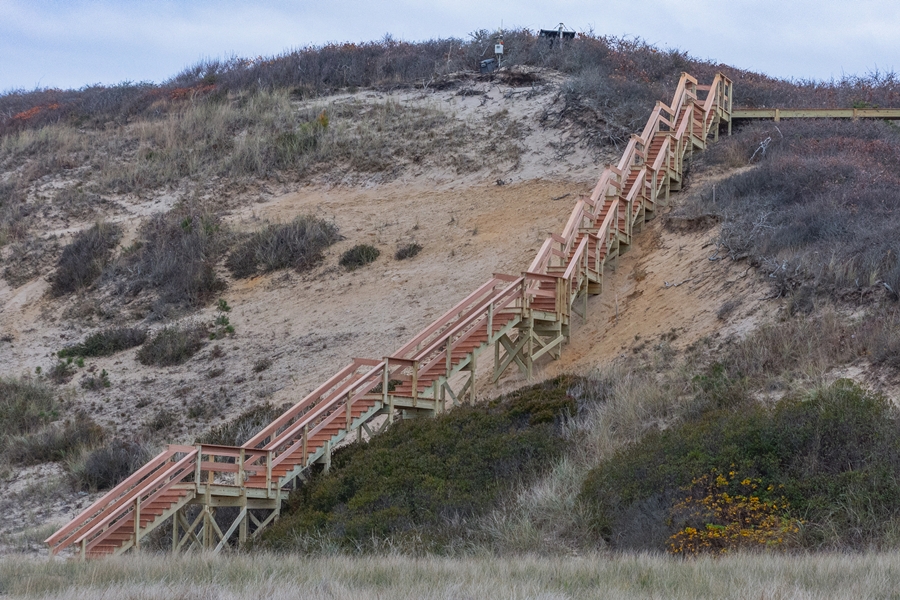TRURO — A 10-foot-wide easement deeded nearly 50 years ago to the owners of a house at 63 Head of the Meadow Road in Truro paved the way for the construction this fall of an unusual accommodation for that house’s new owners: a stairway for private use on Cape Cod National Seashore land.

The stairway zigzags from the ocean beach to the top of the 80-foot-high bluff where Jay Merchant’s vacation house is situated on 5.5 acres overlooking the Atlantic in the Seashore. “There used to be a rope ladder — we were using that,” Merchant told the Truro Conservation Commission during a May 6 review of the plans. “I’ve got a pretty bad leg, and I don’t walk all that great. It wasn’t easy going up and down there.”
Merchant, who lives in Brewster, purchased the property known as “Dolly Hill” in April 2022 for nearly $4 million through his Newcomb Knolls LLC. He spent more than two years obtaining the necessary approvals for the stairway project. They had to come from both the Seashore and the conservation commission, given the overlapping federal and local jurisdictions.
To navigate the approval process, Merchant enlisted Steve McKenna, the Cape Cod and Islands regional coordinator for the Mass. Office of Coastal Zone Management. McKenna helped Merchant evaluate the deeded easement and determine whether it could be used to construct improved beach access.
When Merchant and McKenna showed the easement, included on Merchant’s property plan, to National Seashore authorities, “they were pretty surprised,” McKenna told the commissioners at their May hearing. “They said this was the first time they had seen this existing easement.”
According to McKenna, the discovery raised questions about the easement’s validity and whether construction would be allowed. “It’s highly unusual to permit a private structure within Seashore property,” he said.
But after a review completed last winter, Seashore officials confirmed the easement’s legitimacy. Deputy Supt. Leslie Reynolds told the Independent that the easement was filed on Sept. 29, 1978.
“The owners hold a valid pre-existing easement over federal property which includes beach access to the mean high-water mark of the Atlantic Ocean,” Reynolds said by email.
After that, McKenna told the conservation commission, Seashore staff acknowledged the need for a suitable structure to provide the access specified in the easement. He added that the Seashore hopes to use the stairway to access the beach for its own purposes. Staff have previously done so on informal paths at the edge of the bluff.
McKenna did not respond to phone and text messages seeking comment before the Independent‘s deadline this week. Efforts to contact Jay Merchant through his company, Cape Sand and Recycling in Brewster, were unsuccessful.
Following the Seashore’s determination that the easement was valid, Merchant submitted a draft notice of intent and preliminary construction plans to the Seashore, the conservation commission, and MassWildlife’s Natural Heritage and Endangered Species Program (NHESP). Each evaluated the project under different regulatory standards.
Seashore Supt. Jennifer Flynn signed off on the draft notice of intent and the NHESP application. But when the town’s conservation commission reviewed the plans, members raised concerns about potential effects on the coastal bank and wildlife habitats and requested modifications to ensure compliance with the town’s conservation bylaw and the state’s Wetlands Protection Act.
Commissioner Diane Messinger questioned the need for a stairway in what she said was a sensitive area. “You can get to the beach very easily around the corner,” she said.
Health and Conservation Agent Emily Beebe said that the project was technically replacing a noncompliant rope ladder and pointed to the Seashore superintendent’s approval.
Commissioner Bob White highlighted the sensitivity of vegetation below Merchant’s 14-by-14-foot deck, which was built last year in the coastal bank’s buffer zone with the commission’s approval. Chair Carol Girard-Irwin said she was concerned about potential risks to recent revegetation efforts that were part of the deck project’s mitigation requirements.
Commissioner Clint Kershaw suggested adding a hand-built elevated walkway from Merchant’s deck to the proposed stairway. The commission then voted to continue the review to June 3, allowing time for Merchant to make adjustments that included reducing the stairway’s width from four feet to three feet.
The commission approved the modified project on June 3, contingent on conditions that the property owner revegetate disturbed areas with beach grasses, that there be minimal disturbance to the coastal bank, and that nearby piping plover nesting grounds be protected. Construction began after Labor Day; the stairs and walkway have now been completed.



